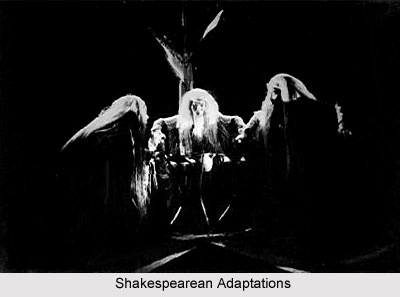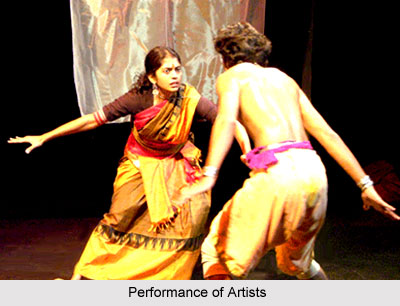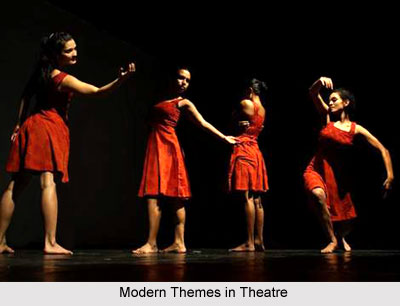 Modern Kannada theatre has had a profound impact on the theatre culture of the Indian state of Karnataka. The term modern Kannada theatre explains the period in Kannada theatre from 1857 to 1950. Right from the initial days, Karnataka had a deep seeded tradition of theatre. Karnataka is known for rich theatre tradition, and folk theatre of Karnataka has grown in concept. The folk forms like the Yakshagana, Doddata and Sannata are essentially ancient forms. These forms of theatre are predominantly from old Mysore area. It must be noted that just like the state of Kerala, the Kathakkali is a dance form, and so is Yakshagana, Doddata and Sannata primary folk theatre forms for the state of Karnataka. As a matter of fact, it was the Yakshagana troupe that actually inspired the development of modern theatre in India, with an improved culture in Regional theatres in India.
Modern Kannada theatre has had a profound impact on the theatre culture of the Indian state of Karnataka. The term modern Kannada theatre explains the period in Kannada theatre from 1857 to 1950. Right from the initial days, Karnataka had a deep seeded tradition of theatre. Karnataka is known for rich theatre tradition, and folk theatre of Karnataka has grown in concept. The folk forms like the Yakshagana, Doddata and Sannata are essentially ancient forms. These forms of theatre are predominantly from old Mysore area. It must be noted that just like the state of Kerala, the Kathakkali is a dance form, and so is Yakshagana, Doddata and Sannata primary folk theatre forms for the state of Karnataka. As a matter of fact, it was the Yakshagana troupe that actually inspired the development of modern theatre in India, with an improved culture in Regional theatres in India.
The British rule impacted hugely to the lifestyle of Kannada people. The conventional and folk forms of theatres slowly moved to the rural corners as the Parsee companies invaded the towns. During the 1875-80, the city of Mysore, witnessed many such Parsey performances. The palace of Mysore witnessed the birth of new troupes known as "Aramane Nataka Company", and also the famous "Gubbi Company". So it can however be concluded that Modern Kannada Theatre was offshoot of new professional Parsee companies. This actually demanded two essential thing, firstly, of course the need for proscenium theatre and secondly, the need of evolving a system to sell the tickets. These professional groups ruled the Kannada theatre till 1950s. They also enjoyed the help of `elite` middle class.
The modern Kannada theatre grew out of the traditional forms and gave itself to new forms inspired from west. The success and improvement of Kannada theatre owes a lot to the richness of Kannada literature. Modern theatre in Karnataka came into existence with the translation from Sanskrit Theatre/Drama during 1870-80.
 The process in which modernity made its entry into Kannada theatre makes for a very interesting story. Contrary to some thoughts, which believe modernity made its entry during 1880s, it can be said that Kannada theatre started getting modern much earlier, during the times when Yakshagana troupes began to travel outside their traditional geographical boundaries. Two major development of Kannada theatre during 1870s and 1880s can be said as the setting up of new troupes and formulation of new kind of dramaturgy - both of which require independent attention. The first was mainly due to the influences from Maharashtra. Parse and Marathi theatre companies from respective states started to travel across the state of Karnataka, and the places they visited, later became those where Kannada troupes were established. Some of the popular theatre troupes that were set up in Karnataka, near the Mysore regions, during this period are; Kritapura Nataka Mandali, Halasagi Company, Chamarajendra Karnataka Nataka Sabha, Rajadhani Nataka Mandali etc. Parallel to establishment of new troupes, new and creative dramas were also written and composed. The works of Santakavi during 1856-1920 and Kerur Vasudevacharya during 1866-1921 reveal the same. Playwrights experimented with their works, and worked on new topics and concepts. While on one hand they translated the plays from Sanskrit language, they also adapted some of the popular Shakespearean plays. This also helped in restructuring the folk and traditional narratives and writing contemporary social drama. . The first Modern Kannada Theatre was published from Mumbai in the year 1887. It is obviously interesting to note that a play like "Iggappa Hegde Vivaha Prahasana" was published during that period. The play dealt with social issues like castes and sub castes. These plays might appear crude in the present day scenario, but the attitude they represent is quite significant.
The process in which modernity made its entry into Kannada theatre makes for a very interesting story. Contrary to some thoughts, which believe modernity made its entry during 1880s, it can be said that Kannada theatre started getting modern much earlier, during the times when Yakshagana troupes began to travel outside their traditional geographical boundaries. Two major development of Kannada theatre during 1870s and 1880s can be said as the setting up of new troupes and formulation of new kind of dramaturgy - both of which require independent attention. The first was mainly due to the influences from Maharashtra. Parse and Marathi theatre companies from respective states started to travel across the state of Karnataka, and the places they visited, later became those where Kannada troupes were established. Some of the popular theatre troupes that were set up in Karnataka, near the Mysore regions, during this period are; Kritapura Nataka Mandali, Halasagi Company, Chamarajendra Karnataka Nataka Sabha, Rajadhani Nataka Mandali etc. Parallel to establishment of new troupes, new and creative dramas were also written and composed. The works of Santakavi during 1856-1920 and Kerur Vasudevacharya during 1866-1921 reveal the same. Playwrights experimented with their works, and worked on new topics and concepts. While on one hand they translated the plays from Sanskrit language, they also adapted some of the popular Shakespearean plays. This also helped in restructuring the folk and traditional narratives and writing contemporary social drama. . The first Modern Kannada Theatre was published from Mumbai in the year 1887. It is obviously interesting to note that a play like "Iggappa Hegde Vivaha Prahasana" was published during that period. The play dealt with social issues like castes and sub castes. These plays might appear crude in the present day scenario, but the attitude they represent is quite significant.
This trend of reshaping the conventional narratives and composing social drama continued through the works of Santakavi during 1856-1920 and Kerur Vasudevacharya during 1866-1921. Likewise, two pioneering translations of Kalidasa`s Sakuntala by Churamuri Sheshagiri Rao in 1869 and Basavappa Shastri in 1880 represent contrasting possibilities. The former employed traditional metres and dialects of north Karnataka, and the latter the complex metres and diction of old Kannada. These diverse and amorphous explorations began to acquire a crystallized form by the turn of the century. On the one hand, strong professional theatre arose and on the other, a variety of amateur experiments started.
 Two of the popular names in modern Kannada theatre are T.P. Kailasam and SriRanga. In more ways than one Kailasam was a Bohemian. Though his uncanny and carefree mannerisms have become myths, but his plays do not completely justify his potential. One may certainly debate the merits of Kailasam`s plays on literary grounds, but Kannada theatre was certainly inspired by people like him. SriRanga, a Sanskrit scholar, published his first play in the year 1930. He was very much familiar with the traditions of Indian theatre. His understanding of the Sanskrit plays and the Natyashastra was unequalled.
Two of the popular names in modern Kannada theatre are T.P. Kailasam and SriRanga. In more ways than one Kailasam was a Bohemian. Though his uncanny and carefree mannerisms have become myths, but his plays do not completely justify his potential. One may certainly debate the merits of Kailasam`s plays on literary grounds, but Kannada theatre was certainly inspired by people like him. SriRanga, a Sanskrit scholar, published his first play in the year 1930. He was very much familiar with the traditions of Indian theatre. His understanding of the Sanskrit plays and the Natyashastra was unequalled.
Shivarama Karanth, another popular personality in modern Kannada theatre, did not restrict himself to realist drama only. His interests ranged from traditional Kannada theatre - Yakshagana, to company theatre. His experimented with themes like opera, burlesque and farce also. In the year 1920, Kailasam wrote his first play, and the following year, in 1921, Samsa, a uniquely strange personality, published his first historical play. He is said to have written 23 plays of which only five or six plays are available.
Kannada theatre received yet another boost with B.M.Srikantiah, the father of Renaissance movement in Karnataka, bringing the Greek forms to look at our own ancient classics with a new perspective.
With the development of Indian cinema, company theatre began to lose its charm and wonder. The new medium, in a way broke the class character of the company theatre and reached even the lower classes.




















